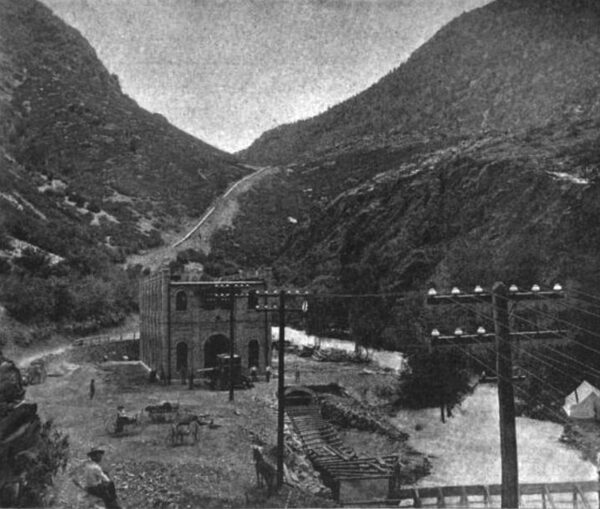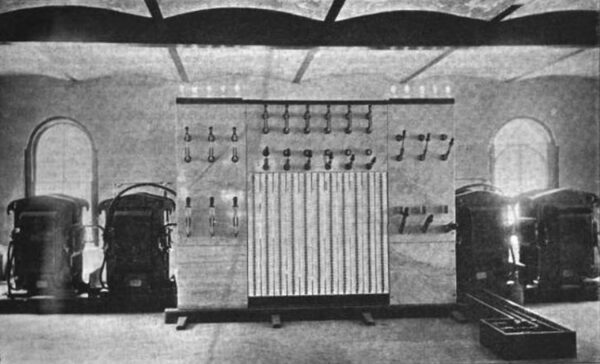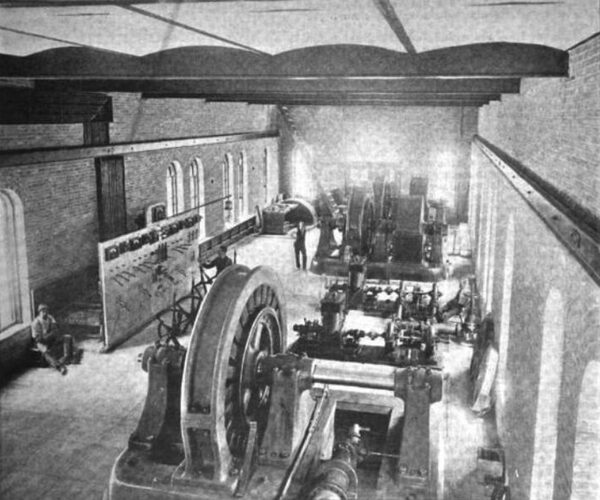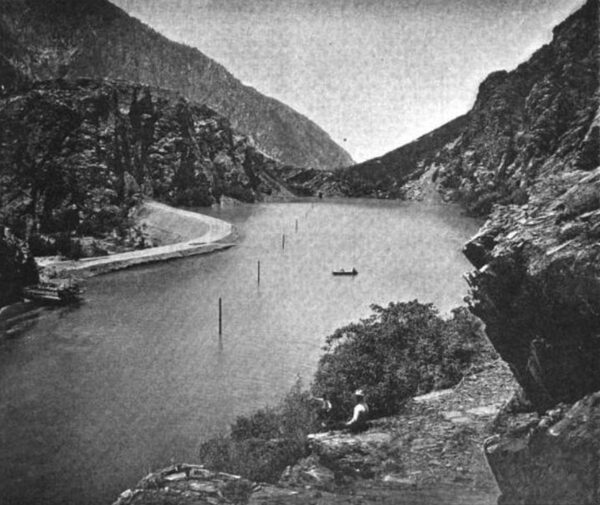[Trade Journal]
Publication: The Electrical Engineer
New York, NY, United States
vol. 22, no. 435, p. 217-221, col. 1-2
POWER TRANSMISSION
THE BIG COTTONWOOD POWER TRANSMISSION, UTAH
NEARLY a year ago, some interesting details were given in The Electrical Engineer (Sept. 11, 1895), of the work about to be done by the Big Cottonwood Power Company in utilizing electrically the water power of eight of the lakes in the Wasatch Mountains and distributing it throughout the valley around Salt Lake City. We are now glad to report that the plans as first proposed by Mr. R. M. Jones and his associates have been carried out and that the plant is to-day in successful operation. A few notes and illustrations of this plant will, therefore, be in order. Events have moved quickly since we first brought the scheme to notice, and last Fourth of July witnessed the entrance of the State of Utah into the Union, when Salt Lake City, with its population of between fifty and sixty thousand celebrated the event with appropriate rejoicing. One feature was the hanging of a huge American flag as a canopy in the big tabernacle, its size being 125 feet by 75, and the forty-fifth star in it, typical of Utah, was a dazzling incandescent lamp.
| |||
| Power House and Pipe Line, Big Cottonwood Transmission. |
It should be premised that the lakes emptying into the Big Cottonwood Canyon, lie at altitudes of from 11,000 to 13,000 feet above the sea, so that the difference of level is considerable even when the water is made to give up its energy at a point some thirteen miles southeast of Salt Lake City. As a matter of fact, the company has available over 1,000 feet of fall, in various spots, but at present is using less than 400. The power station to which we now direct attention is situated in the Canyon at "The Stairs," about 14 miles by pole line from the distributing or "step-down" station of the Salt Lake and Ogden Gas and Electric Light Company, in Salt Lake City. At this point there is a minimum flow of 3,400 cubic feet per minute, which, working under 380 feet head, produces 2,447 horse-power any and every hour in the year. During nine months of each year, it will give nearly 4,000 horse-power.
The storage reservoir at the head of "The Stairs," has an available capacity of 24 hours' continuous flow of the stream, making all of the water available by using an excess during maximum loads and allowing the reservoir to accumulate during minimum loads. 58,800 horse-power hours per day of 24 hours, is looked for from this source, of which 68 per cent. can be delivered in Salt Lake City in contract form, making 40,000 horse-power hours net daily. The 68 per cent. efficiency is derived from Pelton water wheels 80 per cent., General Electric Company generators, 94 per cent., G. E. transformers (raising) 972 per cent., line transmission 95 per cent., G. E. transformers (reducing) 97% per cent., or a total of 682 per cent. The map of the reservoir shows a pipe line extending from the head gates, sub-merged in the bottom of the reservoir, to a penstock or receiver wood housing with "grizzlies" located just below the bridge. by rock piles, and is to be used in the event of its being necessary to drain the reservoir, without interfering with the running of the station. This is accomplished by closing the head gate valves, and the station can thus be supplied from the natural flow of the stream, during such time as the reservoir might be empty.
 |
| Topographical Map of Big Cottonwood Reservoir (B Z), Dam, E, Overflow Gate, (G G G), Submerged Pipe Line, K, "Grizzlies." |
The outside dimensions of the generating station are 34 feet by 100 feet. The generating plant consists of four 450 kilowatt three-phase 60-cycle General Electric generators, separately ex- cited, non-compounded, set with armatures parallel to each other, facing up in true line in the building as shown in plan and in elevation on page 220. Each generator is driven directly by one heavy special Pelton wheel, 60 inches in diameter, provided with two nozzles of 34 in. diameter. The nozzles are provided with hood valves for shutting off, so that both good regulation and economical use of water are secured. Each nozzle at 370 feet effective head, produces 310 mechanical horse-power, and drives the wheel at 300 revolutions per minute, its economical speed. The water wheel is keyed directly on the armature shaft, in lieu of a pulley. In addition to the generators named, four 12½ kilowatt exciters are connected together in pairs by couplings, each set being driven by a 14-inch Pelton wheel, with cast housings. Each set consists of two generators and two wheels, built up on a cast-iron base-plate, making a rigid and direct connection. This application provides exciting energy in two units, and at all times either one or two exciters are in reserve. The exciters are to be run in multiple, and all connected to one common "bus line" on the switchboard. The three-phase generators are also operated in parallel. There are six raising transformers, 265 kilowatts each, of General Electric make.
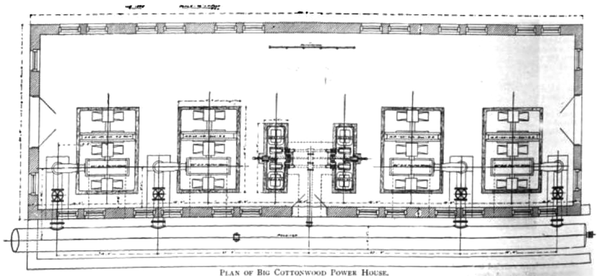 |
| Plan of Big Cottonwood Power House. |
| |||
| Transformer Room, Big Cottonwood Transmission, Salt Lake, Utah. |
The station switchboard consists of 5 panels with complete controlling and indicating apparatus, and there is a 3-panel raising transformer switchboard. At the step down or distributing station, there is a 3-panel reducing switchboard, with proper regulating apparatus. The apparatus is protected by ball lighting arresters, and the transformers are cooled by two Sturtevant exhaust fans driven by two 5 horse-power induction motors.
The 915 poles for the line construction were selected from live growth of Sand Point (Idaho) cedar. The smallest are 40 feet long, and 8 inches in diameter at the top. They are placed 100 feet apart. The line conductors consist of 12 wires, four circuits of three wires each; all No. 2, soft-drawn bare copper, and connected to the same common "bus line," at the generating and at the distributing station. The line loss, in delivering 1,520 kilowatts at 10,000 volts, is something less than 5 per cent.
| |||
| Generating Room, Big Cottonwood Power Transmission Plant. |
The transmission line from generating to distributing station is 14 miles by pole line. The distributing station is owned by the Salt Lake and Ogden Gas and Electric Light Co., who rent it to the Big Cottonwood Power Company at a nominal rent. It contains, for "step-down" transformation, nine 160 kilowatt air blast transformers, from the secondary side of which the Electric Light Company buys the current wholesale by meter. This arrangement is a most convenient one for both companies. The actual terms of the contract are that the electric light company is to be supplied with all the current it can dispose of for electric lighting and power, in units of 10 horse-power, and under, the Big Cottonwood Company reserving the right to supply power to motors in units exceeding 10 horse-power, and the right to reach such wholesale users of power by wires erected on the electric light company's poles, throughout all the districts within the city limits. The contract dates from January 1, 1896, and runs for a term of five years. Its conditions are that the current is bought at 2,000 volts, three-phase, at a stipulated price per k. w. hour, which will be used to supply electric light and power for any purpose up to 10 horse-power, and for elevator service up to any limit de sired by the lessees. 2,000,000 units annually is the minimum limit of the consumption of current.
 |
| Transverse Section of Big Cottonwood Power House. |
The final cost of the complete development is estimated at $300,000. An estimate of $300,000 for the original outlay for "The Stairs" would give for construction expenses-at 2,258 horse-power-$132.72 per net horse-power delivered in the city ready for use. The future of the company seems to be well assured. The company's affairs have been so well administered that much more than half the power to be developed has already been disposed of absolutely, and the guaranteed total revenue from completed contracts is over $100,000 annually. Although the company is confining its operations for the present to "The Stairs" supply, it has, as already stated, other valuable water rights partly developed by means of which it could at any time largely supplement its output.
 |
| Map Showing Big Cottonwood Power Line. |
In order to secure the best results from the three-phase current the Salt Lake Gas and Electric Company, originally a single-phase plant, has modified its distribution system. The new system consists of a network of primary mains with a network of low tension secondaries, wherever the houses are in close proximity to each other. The primary mains are at 2,000 volts. They run along every street east and west and have equalizing cross mains on several streets running north and south. There will eventually be ten feeding points, though a first only six are required. Secondary mains are used almost entirely; only when the houses are very scattered separate house transformers are used. In the commercial district, the secondary and primary mains will eventually be put under-ground, though this is not immediately contemplated. The transformers are placed at street intersections in banks either fixed on the poles or in any suitable location near the intersection. In the commercial districts there will be a bank of transformers at every street intersection; but in the incidental districts one bank will be placed at every other intersection, the blocks being 792 feet square. The feeders are brought from the distributing station situated near the center of the town. The current is supplied from the generators of the Big Cottonwood Power Company's station on the three-phase system. The feeders and primary mains therefore consist of three wires each of the same size. The secondary mains consist of three wires and a neutral wire. The voltage between any one of the three wires and the neutral is 115, and this is the voltage of the lamps. Motors, synchronous or non-synchronous, can be connected at any point to the secondary mains, or, when the motor is large, separate transformers will be used. It is intended to eventually use the alternating current for all arc lamps, in which case they will be connected to the secondary mains with small transformers. At present the arc lighting of the city is done by constant current generators driven by three-phase synchronous motors in the old steam power house of the Salt Lake Gas and Electric Company.
The distributing station is a substantial fireproof building, with a room for the 10,000 volt step-down transformers, the 2,000 volt switchboard and fitted up with instruments for testing and calibrating meters, etc.
| |||
| Dam and Reservoir, Big Cottonwood Electric Power Transmission. |
The distributing system and feeders have been designed of ample capacity for a small drop, and with the complete system of primary and secondary mains the regulation is perfect. By cutting out transformers during times of light load, it is expected to obtain a very high distribution efficiency. The Stairs plant of the company was completed in time to deliver current in Salt Lake City by June 1. A few days after, the greatest flood seen in thirty-five years rushed through the canyon, thus testing in the severest manner the strength of the construction. Not a dollar's worth of damage was done.
The officers of the Big Cottonwood Power Company are John W. Donnellan, president (cashier Commercial National Bank, Salt Lake); W. H. Rowe, vice-president (president Bear River Savings Bank, Salt Lake); G. M. Downey, treasurer (president Commercial National Bank, Salt Lake); R. M. Jones, engineer and manager, Salt Lake; Jos. W. Summerhays, director, Salt Lake. The Old Colony Trust Company, of Boston, is its trustee.
At the present time, The Stairs plant, at ruling rates for current, can earn $200,000 per annum, and it would seem that a ready market exists for light and power now, some 27 concerns using over 2,000 horse-power. Many of these establishments work every day the entire year, and their steam power has cost them from $90 to $145 per horse-power per year.

